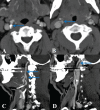Extensive Mobile Thrombus of the Internal Carotid Discovered After Intravenous Thrombolysis: What Do I Do Now?
- PMID: 28400904
- PMCID: PMC5382649
- DOI: 10.1177/1941874416663280
Extensive Mobile Thrombus of the Internal Carotid Discovered After Intravenous Thrombolysis: What Do I Do Now?
Abstract
This case report describes a rare presentation of ischemic stroke secondary to an extensive internal carotid artery thrombus, subsequent therapeutic dilemma, and clinical management. A 58-year-old man was administered intravenous (IV) thrombolysis for right middle cerebral artery territory ischemic stroke symptoms. A computed tomography angiogram of the head and neck following thrombolysis showed a longitudinally extensive internal carotid artery thrombus originating at the region of high-grade calcific stenosis. Mechanical embolectomy was deferred because of risk of clot dislodgement and mild neurological symptoms. Recumbency and hemodynamic augmentation were used acutely to support cerebral perfusion. Anticoagulation was started 24 hours after thrombolysis. Carotid endarterectomy was completed successfully within 1 week of presentation. Clinical outcome was satisfactory with discharge modified Rankin Scale score 0. A longitudinally extensive carotid artery thrombus poses a risk of dislodgement and hemispheric stroke. Optimal management in these cases is not known with certainty. In our case, IV thrombolysis, hemodynamic augmentation, delayed anticoagulation, and carotid endarterectomy resulted in a favorable clinical outcome.
Keywords: carotid artery thrombosis; cerebrovascular disorders; stroke.
Conflict of interest statement
Declaration of Conflicting Interests: The authors declared no potential conflicts of interest with respect to the research, authorship, and/or publication of this article.
Figures


Similar articles
-
Stent-assisted endovascular thrombolysis versus intravenous thrombolysis in internal carotid artery dissection with tandem internal carotid and middle cerebral artery occlusion.Stroke. 2007 Aug;38(8):2270-4. doi: 10.1161/STROKEAHA.106.481093. Epub 2007 Jun 28. Stroke. 2007. PMID: 17600235
-
Carotid embolectomy and endarterectomy for symptomatic complete occlusion of the carotid artery as a rescue therapy in acute ischemic stroke.Case Rep Neurol. 2011 Sep;3(3):301-8. doi: 10.1159/000335069. Epub 2011 Dec 13. Case Rep Neurol. 2011. PMID: 22220158 Free PMC article.
-
Carotid endarterectomy and intracranial thrombolysis: simultaneous and staged procedures in ischemic stroke.J Vasc Surg. 1999 Mar;29(3):459-71. doi: 10.1016/s0741-5214(99)70274-0. J Vasc Surg. 1999. PMID: 10069910 Clinical Trial.
-
Extensive mobile thrombus of the internal carotid artery: a case report, treatment options, and a review of the literature.Am Surg. 2005 Oct;71(10):853-5. Am Surg. 2005. PMID: 16468534 Review.
-
[Treatment of arterial and venous brain ischemia. Experts' recommendations: stroke management in the intensive care unit].Rev Neurol (Paris). 2012 Jun;168(6-7):512-21. doi: 10.1016/j.neurol.2012.01.587. Epub 2012 May 28. Rev Neurol (Paris). 2012. PMID: 22647807 Review. French.
Cited by
-
Acute Hemispheric Stroke: Full Remission Following Surgical Thrombectomy.EJVES Vasc Forum. 2020 Apr 8;47:31-34. doi: 10.1016/j.ejvsvf.2020.03.002. eCollection 2020. EJVES Vasc Forum. 2020. PMID: 33937891 Free PMC article.
References
-
- Bhatti AF, Leon LR, Jr, Labropoulos N, et al. Free-floating thrombus of the carotid artery: literature review and case reports. J Vasc Surg. 2007;45(1):199–205. - PubMed
-
- Ferrero E, Ferri M, Viazzo A, et al. Free-floating thrombus in the internal carotid artery: diagnosis and treatment of 16 cases in a single center. Ann Vasc Surg. 2011;25(6):805–812. - PubMed
-
- Rordorf G, Koroshetz WJ, Ezzeddine MA, Segal AZ, Buonanno FS. A pilot study of drug-induced hypertension for treatment of acute stroke. Neurology. 2001;56(9):1210–1213. - PubMed
-
- Stead LG, Bellolio MF, Gilmore RM, Porter AB, Rabinstein AA. Pharmacologic elevation of blood pressure for acute brain ischemia. Neurocrit Care. 2008;8(2):259–261. - PubMed
LinkOut - more resources
Full Text Sources
Other Literature Sources
